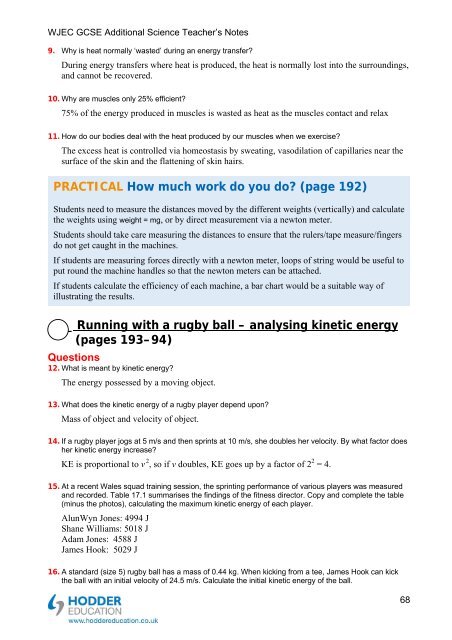Teacher's notes and answers to questions in the book - Hodder Plus ...
Teacher's notes and answers to questions in the book - Hodder Plus ...
Teacher's notes and answers to questions in the book - Hodder Plus ...
You also want an ePaper? Increase the reach of your titles
YUMPU automatically turns print PDFs into web optimized ePapers that Google loves.
WJEC GCSE Additional Science Teacher’s Notes<br />
9. Why is heat normally ‘wasted’ dur<strong>in</strong>g an energy transfer<br />
Dur<strong>in</strong>g energy transfers where heat is produced, <strong>the</strong> heat is normally lost <strong>in</strong><strong>to</strong> <strong>the</strong> surround<strong>in</strong>gs,<br />
<strong>and</strong> cannot be recovered.<br />
10. Why are muscles only 25% efficient<br />
75% of <strong>the</strong> energy produced <strong>in</strong> muscles is wasted as heat as <strong>the</strong> muscles contact <strong>and</strong> relax<br />
11. How do our bodies deal with <strong>the</strong> heat produced by our muscles when we exercise<br />
The excess heat is controlled via homeostasis by sweat<strong>in</strong>g, vasodilation of capillaries near <strong>the</strong><br />
surface of <strong>the</strong> sk<strong>in</strong> <strong>and</strong> <strong>the</strong> flatten<strong>in</strong>g of sk<strong>in</strong> hairs.<br />
PRACTICAL How much work do you do (page 192)<br />
Students need <strong>to</strong> measure <strong>the</strong> distances moved by <strong>the</strong> different weights (vertically) <strong>and</strong> calculate<br />
<strong>the</strong> weights us<strong>in</strong>g weight = mg, or by direct measurement via a new<strong>to</strong>n meter.<br />
Students should take care measur<strong>in</strong>g <strong>the</strong> distances <strong>to</strong> ensure that <strong>the</strong> rulers/tape measure/f<strong>in</strong>gers<br />
do not get caught <strong>in</strong> <strong>the</strong> mach<strong>in</strong>es.<br />
If students are measur<strong>in</strong>g forces directly with a new<strong>to</strong>n meter, loops of str<strong>in</strong>g would be useful <strong>to</strong><br />
put round <strong>the</strong> mach<strong>in</strong>e h<strong>and</strong>les so that <strong>the</strong> new<strong>to</strong>n meters can be attached.<br />
If students calculate <strong>the</strong> efficiency of each mach<strong>in</strong>e, a bar chart would be a suitable way of<br />
illustrat<strong>in</strong>g <strong>the</strong> results.<br />
_ Runn<strong>in</strong>g with a rugby ball – analys<strong>in</strong>g k<strong>in</strong>etic energy<br />
(pages 193–94)<br />
Questions<br />
12. What is meant by k<strong>in</strong>etic energy<br />
The energy possessed by a mov<strong>in</strong>g object.<br />
13. What does <strong>the</strong> k<strong>in</strong>etic energy of a rugby player depend upon<br />
Mass of object <strong>and</strong> velocity of object.<br />
14. If a rugby player jogs at 5 m/s <strong>and</strong> <strong>the</strong>n spr<strong>in</strong>ts at 10 m/s, she doubles her velocity. By what fac<strong>to</strong>r does<br />
her k<strong>in</strong>etic energy <strong>in</strong>crease<br />
KE is proportional <strong>to</strong> v 2 , so if v doubles, KE goes up by a fac<strong>to</strong>r of 2 2 = 4.<br />
15. At a recent Wales squad tra<strong>in</strong><strong>in</strong>g session, <strong>the</strong> spr<strong>in</strong>t<strong>in</strong>g performance of various players was measured<br />
<strong>and</strong> recorded. Table 17.1 summarises <strong>the</strong> f<strong>in</strong>d<strong>in</strong>gs of <strong>the</strong> fitness direc<strong>to</strong>r. Copy <strong>and</strong> complete <strong>the</strong> table<br />
(m<strong>in</strong>us <strong>the</strong> pho<strong>to</strong>s), calculat<strong>in</strong>g <strong>the</strong> maximum k<strong>in</strong>etic energy of each player.<br />
AlunWyn Jones: 4994 J<br />
Shane Williams: 5018 J<br />
Adam Jones: 4588 J<br />
James Hook: 5029 J<br />
16. A st<strong>and</strong>ard (size 5) rugby ball has a mass of 0.44 kg. When kick<strong>in</strong>g from a tee, James Hook can kick<br />
<strong>the</strong> ball with an <strong>in</strong>itial velocity of 24.5 m/s. Calculate <strong>the</strong> <strong>in</strong>itial k<strong>in</strong>etic energy of <strong>the</strong> ball.<br />
68

















